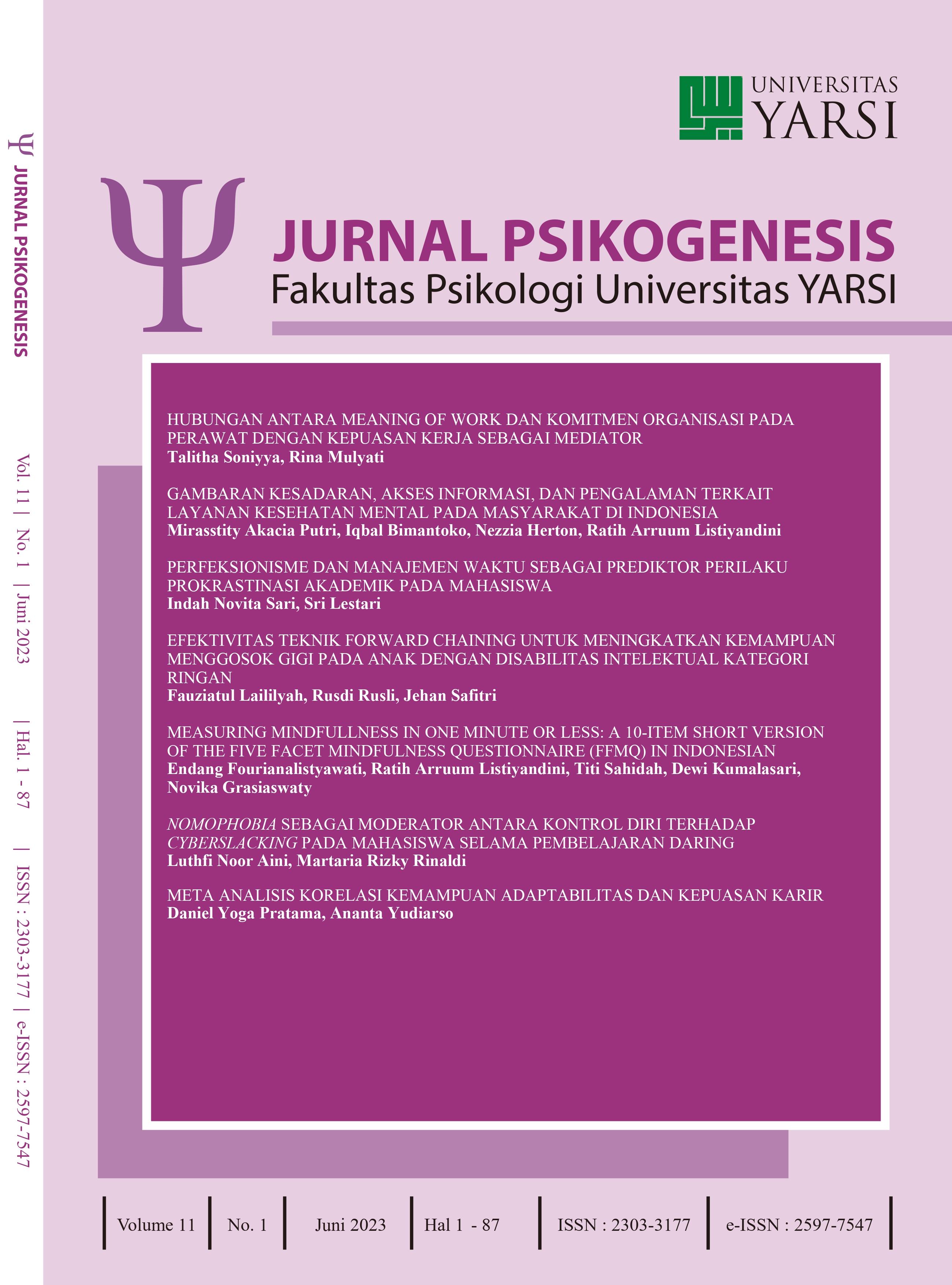Nomophobia Sebagai Moderator Antara Kontrol Diri Terhadap Cyberslacking Pada Mahasiswa Selama Pembelajaran Daring
Kata Kunci:
nomophobia, kontrol diri, cyberslacking, MahasiswaAbstrak
Sebagian besar mahasiswa ternyata melakukan kegiatan akses internet di luar kepentingan akademik saat bersamaan dengan pembelajaran daring. Penggunaan internet yang tidak relevan dengan kegiatan akademik disebut dengan cyberslacking. Penelitian ini bertujuan untuk mengetahui peran moderasi nomophobia pada hubungan kontrol diri terhadap perilaku cyberslacking pada mahasiswa saat melaksanakan pembelajaran daring. Penelitian ini berjenis penelitian kuantitatif, subjek penelitian sebanyak 105 responden mahasiswa. Alat pengumpul data berupa skala kontrol diri, skala nomopobhia dan skala cyberslacking. Analisis data telah dilakukan dengan teknik Moderated Regression Analysis. Hasil penelitian menunjukkan bahwa kontrol diri berpengaruh langsung terhadap cyberslacking, sedangkan nomophobia tidak memoderasi pengaruh kontrol diri terhadap cyberslacking.
Referensi
Agusta, D. (2016). Faktor-faktor Resiko Kecanduan Menggunakan Smartphone pada Siswa Di SMK Negeri 1 Kalasan Yogyakarta. E-Journal Bimbingan dan Konseling Edisi 3 Tahun ke-5. Vol 3. No 5.
Aivaz, K. A., & Teodorescu, D. (2022). College Students' Distractions from Learning Caused by Multitasking in Online vs. Face-to-Face Classes: A Case Study at a Public University in Romania. International journal of environmental research and public health, 19(18), 11188. https://doi.org/10.3390/ijerph191811188
Akbulut, Y., Dursun, Ö. Ö., Dönmez, O., & ?ahin, Y. L. (2016). In Search Of A Measure To Investigate Cyberloafing In Educational Settings. Computers in Human Behavior, 5(5), 616-625.
Ameri, H., Mahami-Oskouei, M., Sharafi, S., Saadatjoo, S., Miri, M., & Arab-Zozani, M. (2023). Investigating the strengths and weaknesses of online education during COVID-19 pandemic from the perspective of professors and students of medical universities and proposing solutions: A qualitative study. Biochemistry and molecular biology education : a bimonthly publication of the International Union of Biochemistry and Molecular Biology, 51(1), 94–102. https://doi.org/10.1002/bmb.21691
Arifin, H.H. & Milla, M.N. (2020). Adaptasi dan properti psikometrik skala kontrol diri ringkas versi Indonesia. Jurnal Psikologi Sosial 18(02), 179-195.
Barrot, J. S., Llenares, I. I., & Del Rosario, L. S. (2021). Students' online learning challenges during the pandemic and how they cope with them: The case of the Philippines. Education and information technologies, 26(6), 7321–7338. https://doi.org/10.1007/s10639-021-10589-x
Baumeister, R. F., Vohs, K. D., & Tice, D. M.
(2007). The strength model of self
control. Current Directions in
Psychological Science, 16, 351–355.
doi:10.1111/j.1467-8721.2007.00534.x
Berry, M. J., & Westfall, A. (2015). Dial D for distraction: The making and breaking of cell phone policies in the college classroom. College Teaching, 63(2), 62–71. https://doi.org/10.1080/87567555.2015.1005040
Bivin, J.B., Mathew, P., Thulasim P.C. Philip, J. (2013). Nomophobia Do We Healty Neet to Worry About? Review of Progress. Vol. 1 Issue 1.
Chiu, T. K. F., Lin, T. J., & Lonka, K. (2021). Motivating Online Learning: The Challenges of COVID-19 and Beyond. The Asia-Pacific Education Researcher, 30(3), 187–190. https://doi.org/10.1007/s40299-021-00566-w
Conrad, C., Deng, Q., Caron, I., Shkurska, O., Skerrett, P., & Sundararajan, B. (2022). How student perceptions about online learning difficulty influenced their satisfaction during Canada's Covid-19 response. British journal of educational technology : journal of the Council for Educational Technology, 53(3), 534–557. https://doi.org/10.1111/bjet.13206
Corner, E. K. (2020). Hambatan dan solusi saat belajar daring dari rumah. Dibuka di https://muda.kompas.id/
Corpus, J. H., Robinson, K. A., & Liu, Z. (2022). Comparing college Students’ motivation Trajectories before and during COVID-19: A Self-Determination Theory Approach. Frontiers in Education, 7. https://doi.org/10.3389/feduc.2022.848643
Dash, S., Samadder, S., Srivastava, A., Meena, R., & Ranjan, P. (2022). Review of Online Teaching Platforms in the Current Period of COVID-19 Pandemic. The Indian journal of surgery, 84(Suppl 1), 12–17. https://doi.org/10.1007/s12262-021-02962-4
Dasiroh, U., Miswatun, S., Ilahi, Y.F., & Nurjannah, N. (2017). Fenomena nomophobia di kalangan mahasiswa.
Demirtepe-Sayg?l?, D., & Metin-Orta, I. (2021). An Investigation of cyberslacking in Relation to Coping Styles and Psychological Symptoms in an Educational Setting. Psychological reports, 124(4), 1559–1587. https://doi.org/10.1177/0033294120950299
Fabriza, R. (2020). Dampak virus covid-19 bagi mahasiswa. Dibuka di https://www.unisbank.ac.id
Fadilah, A. (2011). Pengaruh penggunaan alat komunikasi handphone (hp) terhadap aktivitas belajar siswa smp negeri 66 jakarta selatan. Skripsi, Fakultas Tarbiyah dan Ilmu Keguruan Jurusan Pendidikan Agama Islam Universitas Islam Negeri Syarif Hidayatullah, Jakarta.
Ghozali I. (2013). Aplikasi Analisis Multivariate dengan Program IBM SPSS 21 Up Date PLS Regresi. Edisi 7. Semarang: Badan Penerbit Universitas Diponegoro.
Ghufron, M.N., & Risnawita, R. (2014). Teori-teori psikologi. Yogyakarta: ArRuzz Media.
Ghufron, N., & Rini, R (2017). Teori-Teori Psikologi (Cet. 2). Jogjakarta: Ar-Ruzza media.
Gökçearslan, ?., Uluyol, Ç., & ?ahin, S. (2018). Smartphone addiction, cyberloafing, stress and social support among university students: A path analysis. Children and Youth Services Review, 91(February), 47–54. https://doi.org/10.1016/j.childyouth.2018.05.036.
Hamrat, N., Hidayat, D.R., Sumantri, M.S. (2019). Dampak stress akademik dan cyberloafing terhadap kecanduan smartphone. Jurnal Educato Volume 5 Nomor 1, 2019, Hlm 13-19. DOI: https://doi.org/10.29210/120192324.
Kalayci, E. (2010). Cyberloafing: a multi-dimensional construct place in a theoretical framework (Thesis). Eindhoven University of Technology.
Koessmeier, C., & Büttner, O. B. (2021). Why Are We Distracted by Social Media? Distraction Situations and Strategies, Reasons for Distraction, and Individual Differences. Frontiers in psychology, 12, 711416. https://doi.org/10.3389/fpsyg.2021.711416
Krishna, S. M., & Agrawal, S. (2023). cyberslacking: Exploring the Role of Psychological Wellbeing and Social Media Learning. Behavioral sciences (Basel, Switzerland), 13(8), 649. https://doi.org/10.3390/bs13080649
Lim, V. K. G. (2002). The IT way of loafing on the job. Journal of Organizational Behavior, 23(5), 675–694. https://doi.org/https://doi.org/10.1002/ job.161
Mao, B., Jia, X., & Huang, Q. (2022). How do information overload and message fatigue reduce information processing in the era of COVID-19? An ability–motivation approach. Journal of Information Science, 01655515221118047. https://doi.org/10.1177/01655515221118047
Masadeh, T.S.Y. (2021). Prevalence of nomophobia and cyberloafing behaviors among undergraduate students. European Journal of Education Studies Vol 8 – Issues 2. http://dx.doi.org/10.46827/ejes.v8i2.3580
Meier, A., Reinecke, L., & Meltzer, C. E. (2016). “Facebocrastination”? predictors of using facebook for procrastination and its effects on students? well-being. Computers in Human Behavior, 64, 65-76.
Mustafa Ercengiz , Banu Yildiz , Mustafa Savci & Mark D. Griffiths (2020): Differentiation of self, emotion management skills, and nomophobia among smartphone users: The mediating and moderating roles of intolerance of uncertainty, The Social Science Journal.
O'Neill, T. A., Hambley, L. A., & Chatellier, G. S. (2014). Cyberslacking, engagement, and Personality in distributed work environments. Computers in Human Behavior. DOI : https://doi.org/10.1016/j.chb.2014.08.005
Ozler, D., & Polat, G. (2012). Cyberloafing Phenomenon in Organizations: Determinants and Impacts. International Journal of EBusiness and EGovernment Studies, 4(2), 1–15.
Prasad, S., Lim, V.K.G., & Chen, D.J.Q. (2010). Self-Regulation, individual characteristics and cyberloafing. PACIS 2010 Proceedings. 159.
Putri, K.A.W.K. (2016). Pemanfaatan gadget pada mahasiswa Universitas Muhammadiyah Surakarta. Skripsi, Fakultas Psikologi, Universitas Muhammadiyah Surakarta
Ratten V. (2023). The post COVID-19 pandemic era: Changes in teaching and learning methods for management educators. The International Journal of Management Education, 21(2), 100777. https://doi.org/10.1016/j.ijme.2023.100777
Restubog, S. L. D., Garcia, P., Toledano, L. S., Amarnani, R. K., Tolentino, L., & Tang, R. L. (2011). Yielding to (cyber)-temptation: Exploring the buffering role of self-control in the relationship between organizational justice and cyberloafing behavior in the workplace. Journal of Research in Personality, 45(2), 247–251. https://doi.org/10.1016/j.jrp.2011.01.006
Rinaldi, M. R. (2021). Benarkah Selama Pembelajaran Daring Mahasiswa Mengakses Internet Untuk Kepentingan Non Akademik? Temu Imliah Nasional 2021 "Mengelola ke-Bhinneka Tunggal Ika-an: Tantangan Psikologi di Era New Normal", 573-583. Jakarta: Fakultas Psikologi Universitas Pancasila.
Roberts, N., & Rees, M. (2014). Student use of mobile devices in university lectures. Australasian Journal of Educational Technology, 30(4). https://doi.org/10.14742/ajet.589
Robinso, S. L., Bennett, R. J. (2008). A typology of deviant workplace behavior: A multidimensional scaling study. Academy of Management Journal, 38(2), 555–572.
Sari, S. L., & Ratnaningsih, I. Z. (2018). Hubungan Antara Kontrol Diri Dengan Intensi Cyberloafing Pada Pegawai Dinas X Provinsi Jawa Tengah. Empati, 7(2), 572-574.
Simanjuntak, E., Nawangsari, N. A. F., & Ardi, R. (2022). Academic Cyberslacking: Why Do Students Engage in Non-Academic Internet Access During Lectures?. Psychology research and behavior management, 15, 3257–3273. https://doi.org/10.2147/PRBM.S374745
Susanto, Y.V., & Sokang, Y.A. (2017). Gambaran cyberstalking pada mahasiswa. Prosiding Konferensi Nasional Peneliti Muda Psikologi Indonesia, 2(1), 9.
Talan, T., & Kalinkara, Y. (2022). An investigation of the cyberloafing and nomophobia levels of university students. International Journal of Research in Education and Science (IJRES), 8(2), 430-450. https://doi.org/10.46328/ijres.2708
Wu, J., Mei, W., & Ugrin, J. C. (2018). Student cyberslacking In and Out of the Classroom in China and the Relationship with Student Performance. Cyberpsychology, behavior and social networking, 21(3), 199–204. https://doi.org/10.1089/cyber.2017.0397
Xia, Y., Hu, Y., Wu, C., Yang, L., & Lei, M. (2022). Challenges of online learning amid the COVID-19: College students' perspective. Frontiers in psychology, 13, 1037311. https://doi.org/10.3389/fpsyg.2022.1037311
Yasar, S., Yurdugul, H. (2013). The investigation of relation between cyberloafing activities and cyberloafing behaviors in higher education. Procedia Social and Behavior Sciences, 83, 600 – 604.
Yildirim, C., & Correia., A. (2015). Exploring the dimensions of nomophobia: Development and validation of a self-reported questionnaire. Journal Computers in Human Behavior, Vol.49 Pages 130-137. https://doi.org/10.1016/j.chb.2015.02.059.
Zhang, R., Bi, N. C., & Mercado, T. (2022). Do zoom meetings really help? A comparative analysis of synchronous and asynchronous online learning during Covid-19 pandemic. Journal of computer assisted learning, 10.1111/jcal.12740. Advance online publication. https://doi.org/10.1111/jcal.12740
Unduhan
Diterbitkan
Cara Mengutip
Terbitan
Bagian
Lisensi
Hak Cipta (c) 2023 Luthfi Noor Aini, Martaria Rizky Rinaldi

Artikel ini berlisensiCreative Commons Attribution-NonCommercial-ShareAlike 4.0 International License.
Authors who publish with this journal agree to the following terms:- Authors retain copyright and grant the journal right of first publication with the work simultaneously licensed under a Creative Commons Attribution License that allows others to share the work with an acknowledgement of the work's authorship and initial publication in this journal.
- Authors are able to enter into separate, additional contractual arrangements for the non-exclusive distribution of the journal's published version of the work (e.g., post it to an institutional repository or publish it in a book), with an acknowledgement of its initial publication in this journal.
- Authors are permitted and encouraged to post their work online (e.g., in institutional repositories or on their website) prior to and during the submission process, as it can lead to productive exchanges, as well as earlier and greater citation of published work (See The Effect of Open Access).

 Luthfi Noor Aini
Luthfi Noor Aini
 Universitas Mercu Buana Yogyakarta
Universitas Mercu Buana Yogyakarta










